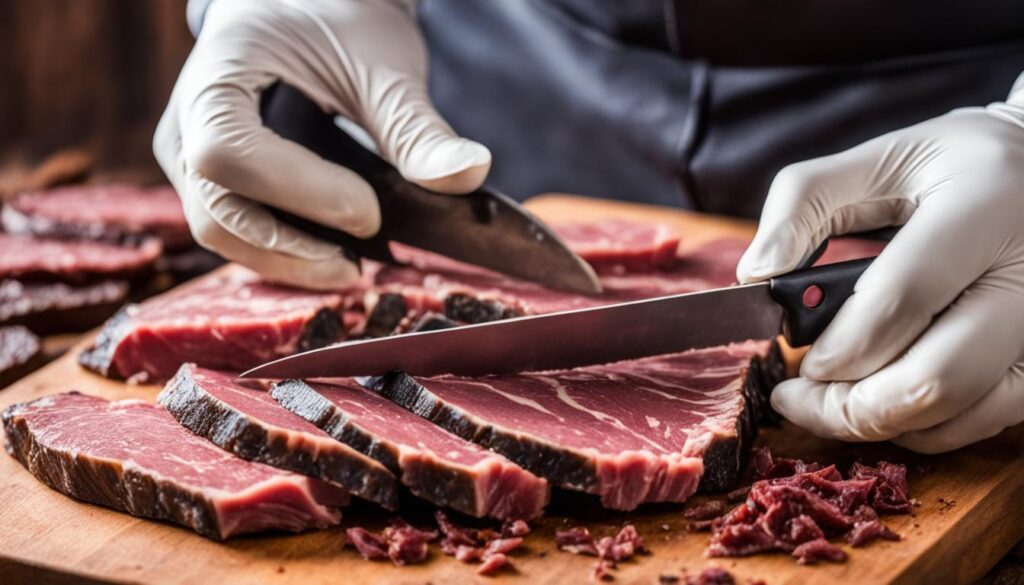Biltong Perfection: Making it in a Dehydrator
Biltong, a popular South African cured and dried meat product, can be easily made at home using a dehydrator. With a simple recipe and the right techniques, you can achieve biltong perfection. Begin by marinating lean cuts of meat in a mixture of vinegar, salt, and spices. Then, let it dry in a dehydrator for 24-72 hours until it reaches the desired level of tenderness. The result? Delicious, homemade biltong that rivals the authentic South African version.
Key Takeaways:
- Making biltong in a dehydrator is an easy and affordable way to enjoy this South African delicacy at home.
- The process involves marinating lean cuts of meat with vinegar, salt, and spices, and drying it in a dehydrator for 24-72 hours.
- Homemade biltong allows you to customize the flavor and experiment with different marinades and spices.
- By making biltong at home, you have control over the quality of the meat and can avoid preservatives.
- Preserving meat at home through dehydration extends its shelf life and provides a tasty and nutritious snack.
The Art of Biltong Making: Tips and Techniques
When it comes to making biltong in a dehydrator, there are a few tips and techniques that can help ensure delicious results. Whether you’re a seasoned biltong maker or a beginner, these pointers will elevate your biltong-making game to new heights.
Choose Quality Cuts of Meat
The key to great biltong starts with selecting high-quality, lean cuts of meat. Top rump beef or venison are excellent choices. The leaner the meat, the better the end result will be. Look for cuts with minimal visible fat.
Cut Along the Grain
When slicing the meat, always cut it against the grain. This helps to create tender and chewable biltong. Cutting along the grain ensures even drying and enhances the overall texture.
Create an Irresistible Marinade
A well-balanced marinade is the heart and soul of biltong. Combine vinegar (malt or cider), salt, black pepper, and coriander seeds for a classic biltong flavour. Feel free to experiment with additional spices and flavours to customise your biltong recipe to your liking.
Let the Flavours Marinate
After coating the meat with your marinade, let it marinate in the fridge overnight. This allows the flavours to penetrate the meat, resulting in a more delicious and aromatic biltong. The longer it marinates, the stronger the flavours will be.
Prioritize Proper Drying
Once the marinating process is complete, pat the meat dry with a paper towel to remove excess moisture. Then, hang the meat in the dehydrator using hooks or clips. The drying time will vary depending on the thickness of the meat and desired doneness. Generally, biltong is ready in 24 to 72 hours.
Variations and Alternatives
If you’re looking to experiment with different flavors, try adding Worcestershire sauce, paprika, or chili flakes to your marinade. These additions can add a delightful twist to your biltong recipe. Additionally, biltong can serve as a tasty alternative to beef jerky, providing a unique South African twist.
With these tips and techniques in your arsenal, you’re ready to embark on your biltong-making journey. So fire up your dehydrator, marinate your meat, and let the flavors unfold as you create your own batch of mouthwatering South African biltong.

Biltong Recipe Variations
Here are a few biltong recipe variations to try:
- Spicy – Add extra chili flakes or cayenne pepper to the marinade for a fiery kick.
- Sweet and Smoky – Incorporate brown sugar and smoked paprika for a caramelized and smoky flavor profile.
- Teriyaki – Replace the traditional biltong marinade with a mixture of soy sauce, ginger, and garlic for an Asian-inspired twist.
- Herb-infused – Experiment with fresh or dried herbs such as rosemary, thyme, or oregano to add a herbal note to your biltong.
The Advantages of Homemade Biltong
Making biltong in a dehydrator at home offers several advantages. Firstly, you have complete control over the ingredients and can ensure the use of high-quality, preservative-free meat. This allows you to customise the flavour profile of your biltong by adjusting the spice blend and experimenting with different marinades.
Additionally, making biltong at home can be a cost-effective option compared to store-bought varieties. By purchasing bulk cuts of meat and utilizing a dehydrator, you can save money in the long run. Imagine the satisfaction of enjoying your own homemade biltong while also cutting down on the grocery bill!
Furthermore, homemade biltong allows you to explore different types of meat beyond traditional beef, such as venison or even chicken. This opens up a world of flavor possibilities and adds variety to your snacking options. Why stick to just one type of biltong when you can experiment with different meats and find your personal favorite?
Last but not least, preserving meat at home through the process of dehydration helps extend its shelf life. You can stock up on homemade biltong, ensuring you always have a delicious and nutritious snack on hand. Whether you’re hiking, camping, or simply craving a protein-packed treat, homemade biltong is the perfect solution.
FAQ
How do I make biltong in a dehydrator?
To make biltong in a dehydrator, start by marinating lean cuts of meat in a mixture of vinegar, salt, and spices. Then, dry the marinated meat in the dehydrator for 24-72 hours until it reaches the desired level of tenderness. Finally, slice the cured biltong into bite-sized pieces and enjoy!
What cuts of meat should I use for biltong?
It’s best to use high-quality, lean cuts of meat such as top rump beef or venison for making biltong. These cuts work well because they have less fat content, which helps with the drying process.
Can I customize the flavor of my biltong?
Absolutely! You can personalize your biltong recipe by experimenting with different spices and flavors in the marinade. In addition to the traditional vinegar, salt, black pepper, and coriander seeds, you can add other spices like chili powder, garlic powder, or paprika to suit your taste.
How long does it take to dry biltong in a dehydrator?
The drying time for biltong in a dehydrator can vary depending on the thickness of the meat and your desired level of doneness. It typically ranges from 24 to 72 hours. Keep an eye on the biltong and check for the desired texture throughout the drying process.
Can I use different types of meat for biltong?
Absolutely! While beef is the most common meat used for biltong, you can also try using other meats such as venison or even chicken. Each type of meat will give your biltong a unique flavor profile, so don’t be afraid to get creative!
What are the advantages of making biltong at home?
There are several advantages to making biltong at home. Firstly, you have control over the ingredients and can ensure the use of high-quality, preservative-free meat. Additionally, making biltong at home allows you to customize the flavor to your liking. It can also be a cost-effective option compared to store-bought varieties and allows you to explore different types of meat. Lastly, by dehydrating and preserving meat at home, you can extend its shelf life and always have a delicious and nutritious snack on hand.
